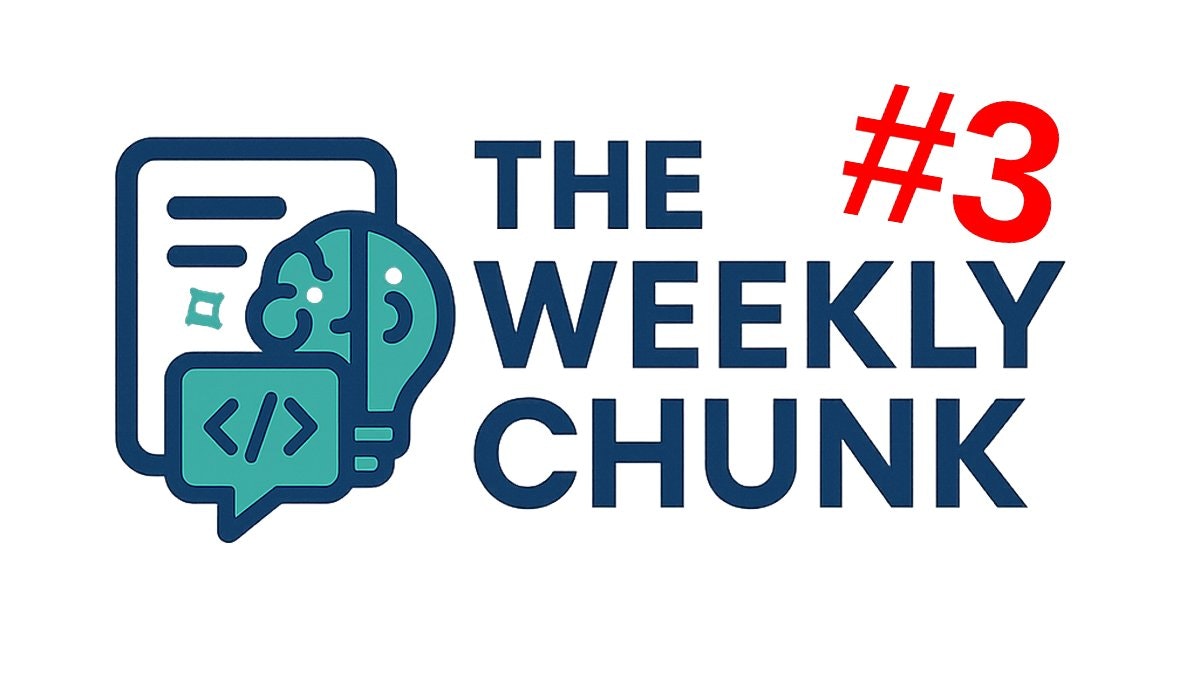Advanced AI techniques in this Week's Chunk. Dive into Shopify's LLM scaling, Amazon S3 Vectors, the ReAct reasoning framework, and the crucial shift to context engineering.
Has the novelty of AI-generated poetry and simple chatbots started to fade for you? If so, you're not alone. The industry is rapidly maturing beyond flashy demos and single-prompt magic tricks. The new frontier isn't just about what AI can do, but how we can build robust, scalable, and genuinely intelligent systems that solve complex, real-world problems. This operational shift is where the real work-and the most significant breakthroughs-are happening right now, focusing on the foundational layers of data, infrastructure, and reasoning that separate toy projects from enterprise-grade solutions.
This week's digest dives deep into this architectural evolution. We explore how the focus is moving from crafting the perfect prompt to engineering the perfect context-the complete informational workspace an AI needs to perform with precision. We'll see this in action with a look at how Shopify is leveraging multimodal LLMs to tame a chaotic, global-scale product catalog, transforming unstructured data into a powerful engine for modern commerce. To support such massive undertakings, we'll also cover Amazon's new S3 Vectors, a purpose-built storage solution designed to dramatically lower the cost and complexity of working with AI-ready data at scale.
Finally, we'll get tactical by examining the frameworks that are making AI more "agentic" and human-like in its problem-solving. We'll break down the ReAct framework, which teaches models to reason, act, and observe in a dynamic loop, significantly improving coherence and reducing errors. This digest is packed with actionable insights on the foundational strategies and tools that are defining the next generation of AI, providing a clear roadmap for building applications that are not just intelligent, but truly useful.
Shopify's Global Catalogue addresses the challenge of fragmented product data by using multimodal LLMs to create a unified, structured understanding of billions of products. This intelligence layer is crucial for powering modern AI-driven commerce, from conversational agents to semantic search. The system transforms unstructured text and images into canonical product records by classifying products, extracting attributes, and matching items across millions of merchants.
To achieve this at a scale of 40 million daily inferences, Shopify fine-tunes open-source models with a novel "selective field extraction" training strategy. This multi-task learning approach significantly improved efficiency, reducing median latency to 500ms and cutting GPU usage by 40%. An automated annotation pipeline using an "LLM arbitrator" and human-in-the-loop review ensures high-quality training data.
The result is a powerful foundation that enhances search, personalization, and conversational shopping. The core takeaway is that creating a reliable, machine-readable product catalog is fundamental to unlocking the full potential of AI in e-commerce.
Amazon has introduced Amazon S3 Vectors (now in preview), marking the first time a cloud object storage service supports vectors natively at scale. This new S3 bucket type is tailored for storing massive vector datasets - used for embeddings of documents, images, audio, and video-offering APIs that let you store, update, query, and filter vectors with sub‑second response times. Each "vector bucket" can contain up to 10,000 indexes, with each index holding tens of millions of vectors along with metadata, enabling semantic search and similarity queries without needing dedicated infrastructure.
With S3 Vectors, AWS reports cost savings of up to 90% on storing and querying vectors compared to traditional vector databases. The service seamlessly integrates with Amazon Bedrock Knowledge Bases, SageMaker Unified Studio, and Amazon OpenSearch, allowing users to centralize “cold” vector data in S3 and promote “hot” data into OpenSearch for low-latency use cases. It's designed for non-real-time or batch operation - like RAG, recommendation systems, intelligent document processing, and AI agent memory - where some latency is acceptable in exchange for simpler management and dramatically lower costs.
In short, Amazon S3 Vectors brings scalable, serverless, and cost-effective vector storage capabilities directly into Amazon S3. It streamlines the deployment of AI workloads that rely on vector embeddings by eliminating the need for separate vector databases, while integrating naturally with existing AWS services to support a wide range of generative AI applications.
Large Language Models (LLMs) rely heavily on the context they're given, and the emerging discipline of Context Engineering aims to optimize that input to unlock their full potential. This survey introduces a structured framework that breaks down Context Engineering into three foundational pillars: Context Retrieval and Generation, Context Processing, and Context Management - and shows how these building blocks come together in powerful systems like Retrieval-Augmented Generation (RAG), memory-based architectures, and tool-using agent systems.
Despite rapid innovation, research in this space has been fragmented and siloed. This paper unifies the field by reviewing over 1400 works and presenting a clear taxonomy that clarifies connections between techniques and identifies gaps - particularly the inability of LLMs to generate context-rich long-form outputs as well as they can understand them. It offers a roadmap for researchers and builders alike to design smarter, more context-aware AI systems by treating context not as an afterthought, but as a first-class engineering discipline.
AI experts are shifting focus from prompt engineering to context engineering, recognizing that an AI's usefulness hinges on the information it's given. The core idea is simple: instead of just giving the AI a command, you provide a complete "workspace" with relevant data, tools, and user history. This transforms generic responses into tailored, genuinely helpful answers.
This is done by selecting relevant data, compressing large documents, and isolating complex problems. However, this approach isn't foolproof. Key challenges include the "lost in the middle" problem, where AIs ignore data placed in the middle of a context, and significant security risks like malicious prompt injection.
Actionable takeaways for building effective systems include setting clear goals, placing critical information at the beginning or end of the context, and testing rigorously. Mastering context is the key to creating AI that is truly intelligent and useful in the real world.






